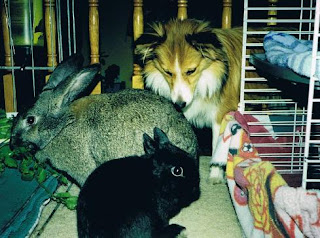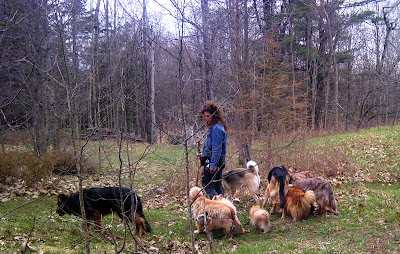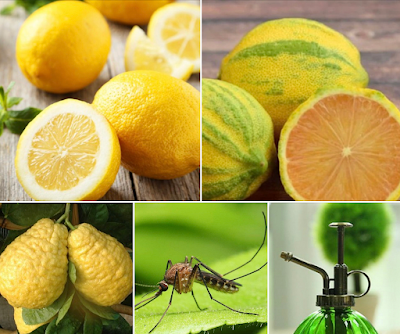TO INTRODUCE YOUR DOG TO A CAT, RABBIT...
So, you would like to introduce your dog to a cat or another non-canine animal, maybe a rabbit!
Our role in a dog-to-other animal meeting is to mindfully coach and mentor, not to stress and panic.
Teaching your dog good social manners with other animals starts with training yourself.
 | |
| My smaller cat 'Callie' waiting for the dogs to go by - as the dogs walk by she plays with their tails! |
IF YOU'VE TRIED INTRODUCTIONS BEFORE & ITS HAS NOT GONE WELL…
Make the future different than the past. Let the past go. Mindfully ground yourself in logic, not emotion. Be strategic, be committed to creating normal.
 |
| Tibby, my larger cat with Robbie the Boxer and Sarah the German Shepherd x Siberian Husky |
THE TWO BIGGEST MISTAKES PEOPLE MAKE…
ONE - Not having a basic understanding of what they themselves are communicating to their dog!
TWO - Being nervous, anxious, fearful, anticipating problems. There's a vast difference between anticipating and being strategic.
When you're nervous about your dog being around your cat, you are telling your dog to be uncomfortable with the situation. Your dog will associate cats with nervousness, tension and fear. Be strategic, be logical. Put in-place the structure your dog needs to feel confident, not nervous. Establish normal. So, let's get started...
DO YOU REALLY KNOW WHAT YOU ARE COMMUNICATING?
Before you answer ‘yes, of course I know how to communicate' please read on. If greetings have not always gone well in the past and you anticipate that this new greeting will also go badly - I assure you, you are right - it will not go well!
Before you answer ‘yes, of course I know how to communicate' please read on. If greetings have not always gone well in the past and you anticipate that this new greeting will also go badly - I assure you, you are right - it will not go well!
Dogs are very sensitive and use their senses (sight, scent, sound) more keenly and consciously than people do. Dogs read stress & emotion in people before a person is even aware of how they themselves feel. They do look at our face to read our reactions. A little tension in a persons shoulder, clinching of a hand, tightness of the lips, narrowing or widening of the eyes, change in breathing, sweating. They know what you are thinking, what you are feeling! The affect of our state-of-being on our dogs is profound. If you anticipate trouble you create trouble! You create tension and sometimes that is all that is required to trigger reactivity in your dog. This tells your dog that you are not in control and therefore it cannot trust you or the situation. Your dog becomes insecure and nervous, even fearful. This is the trigger for reactivity - what you see as aggression.
Make sure you are not tense, stressed or anticipating reactive (what you probably think of as aggressive) behavior from your dog. To lead by example you must be without any such emotions. You must be (calm) and have confidence in yourself and in your dog. Your state of calm, confidence will set the framework for your dog’s state. If your thoughts and body language are relaxed and confident you indicate to your dog that you are confident with the situation - this allows your dog to relax and normalize the experience of meeting another animal.
I am going to give you a few articles to read. Please read them as it is critical that you understand how dogs communicate and how we unintentionally communicate the wrong message to them.
How Dogs Communicate
How Dogs Assign Respect
So train yourself to control your thoughts, your emotion and direct your focus. Only then can you properly support your dog. Remember you communicate with your state-of-mind, and hence your body…not just by the words or the tone you use to speak.
DO YOU REALLY KNOW HOW TO DIRECT YOUR DOG?
Seems an impertinent question for me to ask but from working with my clients, I know many people do not realize that they only give their dog the beginning of an instruction. Then the poor dog is vilified for not doing what the human thinks they told the dog to do!
To direct properly you must be calm, confident and provide a full set of instructions. A full set of instructions consists of:
1. Getting your dogs attention;
2. Letting your dog know what you do not what him to do;
3. Letting your dog what you do want him to do instead, and;
4. Following through to correct your dog if he backslides into the unwanted behavior.
The leadership role is one of coaching and mentoring with fair, firm, clear direction. Never match your dog’s state but you do have to match the intensity of his behavior. I see a lot of people doing only step 2. Then the poor dog gets in trouble as it goes back to doing the unwanted behavior as its human has not provided a full set of instructions! Blame yourself, not your dog!
Here are some articles you can read to understand leadership and help you hone your Leadership skills...
Be Your Dog’s Coach and Mentor
De-Bunking the Alpha Myth
Dogs and Affection
The Golden Rule
IT IS EASIER TO WORK WITH A DOG WHO HAS EXPENDED ITS ENERGY
I always say that dogs have two types of energy;
A - their daily quota of energy, and;
B - if they have not had enough exercise on a regular daily basis they can have stored energy in addition to daily energy;
They can also have a third type of energy - anxious energy! If your dog has anxiety issues it may also have nervous energy which results in chewing objects or itself, scratching itself, etc.
Dogs need to expend their energy to feel relaxed and calm. You cannot expect a dog with unspent energy to be focused and ‘reasonable’, happy or balanced. Dogs need to expend their energy on a regular (daily) basis.
Just as we would find it difficult to settle down if we were revved up, so to do dogs - even more so. Unspent energy can lead to frustration making a dog more reactive and less attentive!
Before the introduction - give your dog a chance to expend its energy.
I always say that dogs have two types of energy;
A - their daily quota of energy, and;
B - if they have not had enough exercise on a regular daily basis they can have stored energy in addition to daily energy;
They can also have a third type of energy - anxious energy! If your dog has anxiety issues it may also have nervous energy which results in chewing objects or itself, scratching itself, etc.
Dogs need to expend their energy to feel relaxed and calm. You cannot expect a dog with unspent energy to be focused and ‘reasonable’, happy or balanced. Dogs need to expend their energy on a regular (daily) basis.
Just as we would find it difficult to settle down if we were revved up, so to do dogs - even more so. Unspent energy can lead to frustration making a dog more reactive and less attentive!
Before the introduction - give your dog a chance to expend its energy.
 |
| Shanny my GSD x Malamute and Benjamen |
LEARN TO READ YOUR DOG AND BE AWARE
I have worked with many clients’ who love their dog very much, but they think that their dog is a bad dog as the dog exhibits unwanted behavior. I notice that the dog makes good eye contract, constantly looking at its people…but the people don’t see. The dog is trying to be positively opportunistic, but its attempts fail time and time again, because the humans are not aware and don’t see that their dog is asking for direction.
After providing direction to the dog once or twice, the dog quickly understands that it can look at me for direction and I will provide the coaching and mentoring it is seeking - the dog is a positive opportunist. It always was it’s just that no one was paying attention.
Just imagine how upsetting and frustrating this is for the dog. Yet the dog has never stopped trying…even though it was often reviled by its humans for being bad!
In the absence of direction the dog has little choice but to make up its own rules. Take advantage of the fact that your dog looks to you for direction - direct! I will show you how to really direct below.
SO LETS GO GREET THE CAT!
I have worked with many clients’ who love their dog very much, but they think that their dog is a bad dog as the dog exhibits unwanted behavior. I notice that the dog makes good eye contract, constantly looking at its people…but the people don’t see. The dog is trying to be positively opportunistic, but its attempts fail time and time again, because the humans are not aware and don’t see that their dog is asking for direction.
After providing direction to the dog once or twice, the dog quickly understands that it can look at me for direction and I will provide the coaching and mentoring it is seeking - the dog is a positive opportunist. It always was it’s just that no one was paying attention.
Just imagine how upsetting and frustrating this is for the dog. Yet the dog has never stopped trying…even though it was often reviled by its humans for being bad!
In the absence of direction the dog has little choice but to make up its own rules. Take advantage of the fact that your dog looks to you for direction - direct! I will show you how to really direct below.
SO LETS GO GREET THE CAT!
 |
| Jordie my German Shepherd x Alaskan Malamute and April |
ONE - SET THE FRAMEWORK
You have to set the framework before you move forward with the meeting.
A - Your dog needs to be, calm and quiet before you approach your cat. Don't allow your dog to move towards the cat while your dog is in an excited state. If you're doing an on-leash introduction, make sure your dog is calm before you attach the leash to his collar or harness.
B - Your posture should be upright, confident, not tense. Be mindfully aware of any tension in your chest, shoulders, arms and hands. If using a leash make sure there's no tension in your grip. If you grip the leash with tension, if your arms and shoulders are stiff with apprehension, you're creating and enabling tension, stress, and anxiety. Let the tension go and concentrate on directing yourself.
C - As you approach your cat, have your dog stand behind you or beside. Your dog should not be in front of you, your dog should not be pulling on his leash.
If you or your dog is not calm, STOP. Don't continue moving forward. Mindfully release all tension you;re feeling, take a deep breath, ground yourself, still yourself. Breathing is communication. You'll find a breathing communication exercise to do with your dog here. Be that thing you need your dog to be. Once your dog is calm, instruct him to move calmly forward at your side.
 |
| Stevie my Sheltie, with Ginger and Benjamen |
TWO - ENCOURAGE YOUR DOG TO USE HIS SENSE OF SMELL
Encourage your dog to use his sense of smell, to greet your cat. In their natural state, dogs greet each other by smelling each other. They don't jump all over each other in an excited state. Excited greetings occur because we humans teach our the dogs that greeting (a human - child or adult, another animal) requires excitement. This is not a dog’s way. It is a human’s way. Be mindful, direct the situation from a place of logic, make the greeting normal and comfortable.
THREE - MAKE SURE YOUR DOG DOES NOT TAKE OVER
Remember it is your job to coach and mentor your dog. If you want your dog to give space and not crowd you have to tell it. If your dog is a little to eager / pushy you need to disagree with your dog's behavior.
Remember it is your job to coach and mentor your dog. If you want your dog to give space and not crowd you have to tell it. If your dog is a little to eager / pushy you need to disagree with your dog's behavior.
For instance your dog places his paws on the cat with a little too much energy or wants to lick the cat's face too much. Touch your dog and say 'uh' and then say 'gentle'. Touch gets his attention, 'uh' to indicate the behavior is not appropriate and 'gentle' to provide the right direction.
Dogs also claim space by moving into the space. If your dog crowds the cat too much you need to claim the space back.
Think for a moment about the tools and strategy that your dog uses to take over your space and your cat's space. Your dog uses his body. Use your body to herd him out of the space while using your grounded, mindfulness to support your body language.
Use your body to herd your dog out of the space. To do this, walk into the space your dog is occupying, or use your body by leaning slightly toward your dog, or use your hand/arm to indicate to your dog that he is to move.
The technique you choose depends on what works well for you and your dog, and as well, how committed your dog is to taking over the space.
Be mindful. Be grounded. Be 100% committed to coaching your dog through the situation.
I also recommend you read me article:
To Stop Your Dog From Chasing Your Cat
I cannot state enough how important it is to be grounded, calm, confident and patient. Mindfulness is essential.
Dogs also claim space by moving into the space. If your dog crowds the cat too much you need to claim the space back.
Think for a moment about the tools and strategy that your dog uses to take over your space and your cat's space. Your dog uses his body. Use your body to herd him out of the space while using your grounded, mindfulness to support your body language.
Use your body to herd your dog out of the space. To do this, walk into the space your dog is occupying, or use your body by leaning slightly toward your dog, or use your hand/arm to indicate to your dog that he is to move.
The technique you choose depends on what works well for you and your dog, and as well, how committed your dog is to taking over the space.
Be mindful. Be grounded. Be 100% committed to coaching your dog through the situation.
I also recommend you read me article:
To Stop Your Dog From Chasing Your Cat
I cannot state enough how important it is to be grounded, calm, confident and patient. Mindfulness is essential.
Holistic Diet, Nutrition, Wellness Services Tailored to Your Individual Dog and Cat
For information about my holistic diet, nutrition and wellness services, visit my holistic wellness services page.
Maintain good health | Address acute and chronic health issues | Pre and post surgery support and recovery
My holistic wellness services are available worldwide via video consultation.
🌎 USA | Canada | UK | Europe | Australia | New Zealand | Asia | South and Central America | Africa | UAE
📱FaceTime | Facebook | Skype | WhatsApp
To set-up your holistic wellness consultation get in-touch via email, go to my contact me page.
Holistic Behavioral Services for Your Dog
For information about my holistic behavioral services, visit my holistic behavioral services page.
For dogs of all ages, sizes and breeds.
My behavioral services are available worldwide via video consultation.
🌎 USA | Canada | UK | Europe | Australia | New Zealand | Asia | South and Central America | Africa | UAE
📱FaceTime | Facebook | Skype | WhatsApp
To set-up your holistic behavioral session get in-touch via email, go to my contact me page.
Affiliations to Companies
✓ None.
✓ I don't sell food, supplements, or other products.
✓ I'm not aligned with any companies.
Article and graphics by Karen Rosenfeld.












